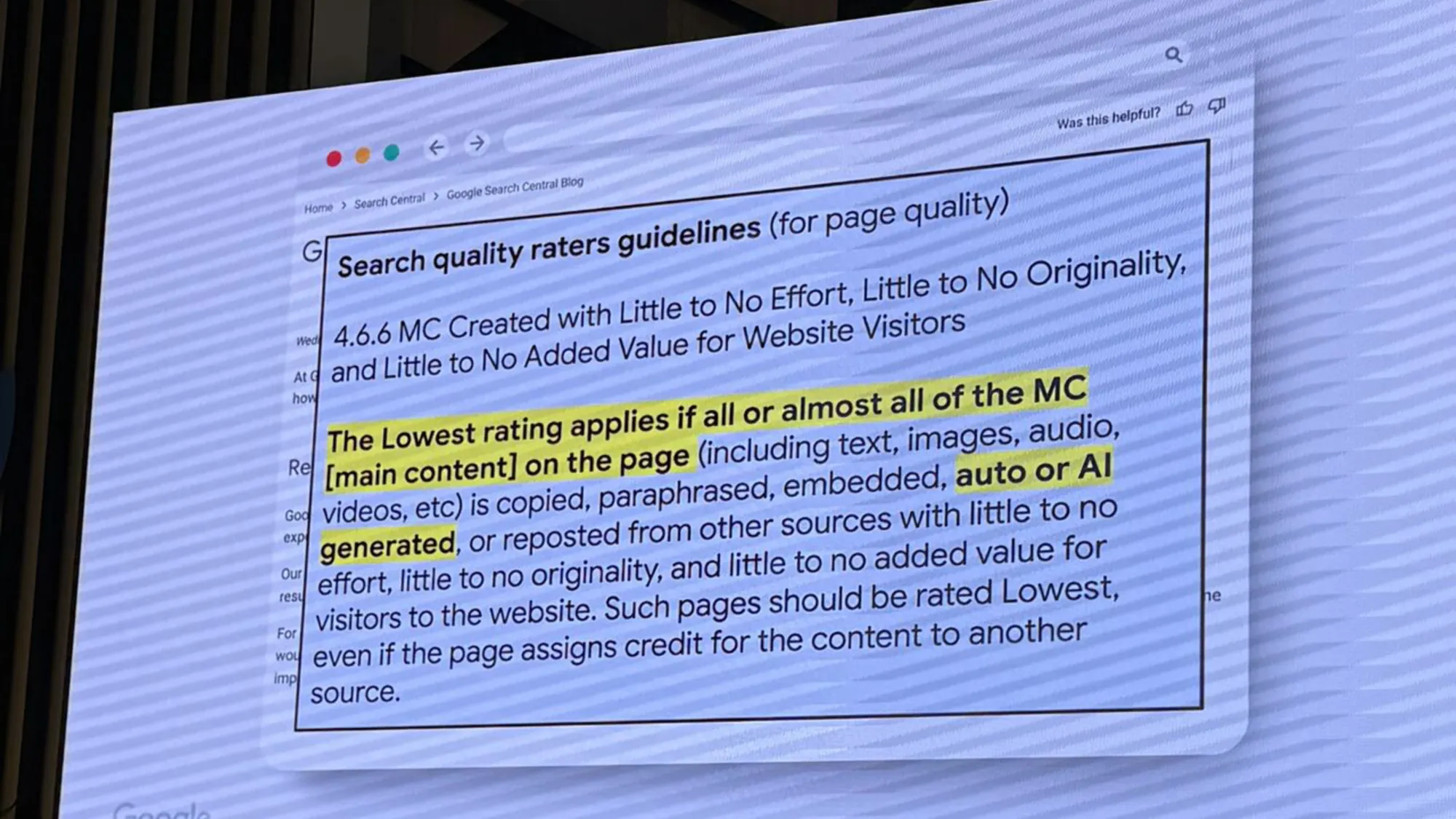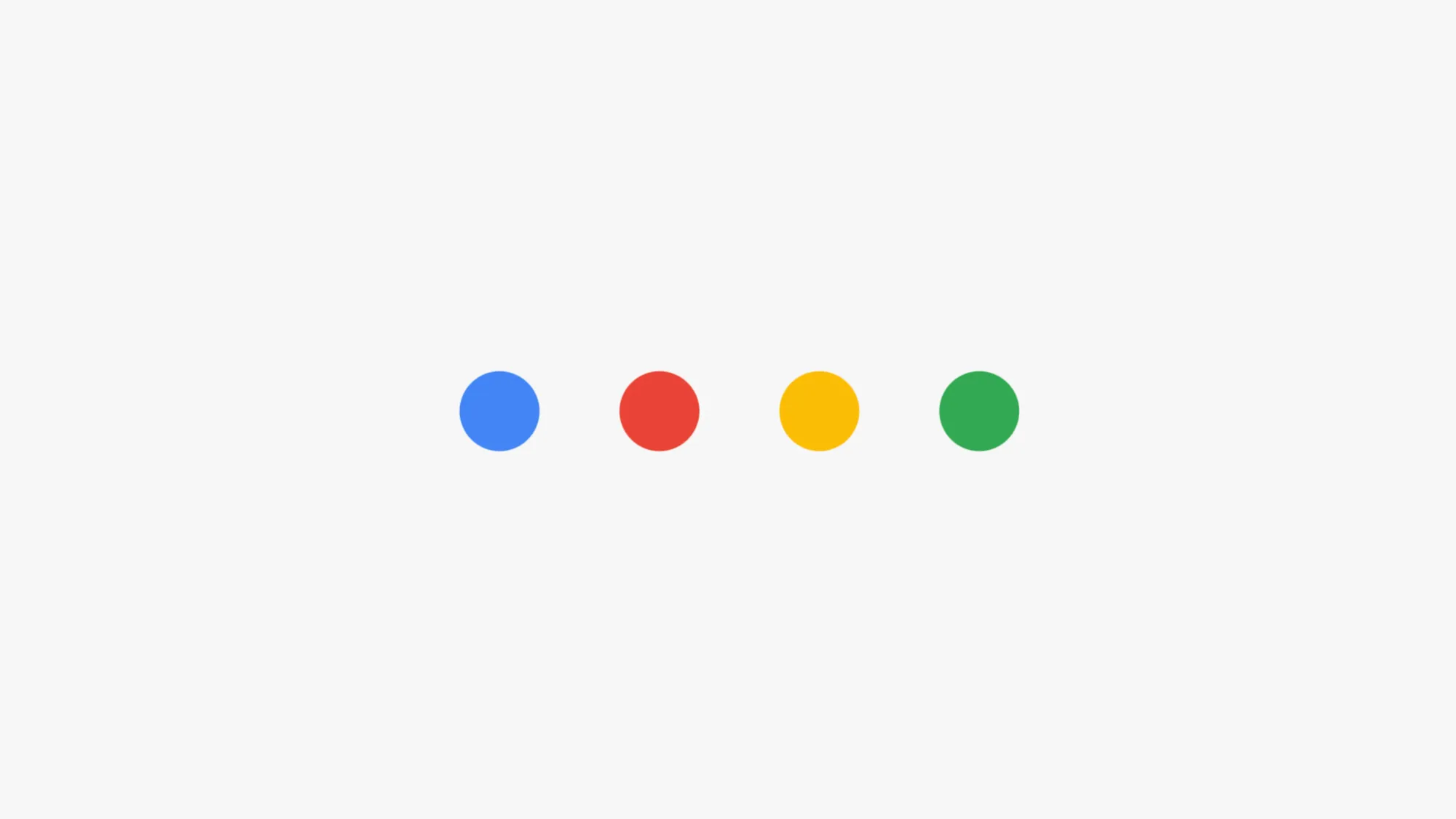Google updates quality rater guidelines with AI content evaluation criteria
Google's latest guidelines provide clearer direction on evaluating AI-generated content and spam tactics.

Three months ago, Google updated its Search Quality Rater Guidelines with significant changes regarding artificial intelligence content evaluation and expanded spam definitions.
On April 9, 2025, information surfaced that Google has directed its quality raters to identify pages with main content created using automated or generative AI tools and potentially rate them as lowest quality. This news was shared by Google's Senior Search Analyst and Search Relations team lead John Mueller during Search Central Live in Madrid.
The announcement builds upon Google's January 2025 update to its Search Quality Rater Guidelines, which included several significant changes to how the company evaluates web content. These guidelines serve as instructions for human evaluators who assess the quality of search results, though their ratings don't directly affect search rankings.
"Google updated their Search Quality Raters Guidelines document for the first time since November 2023," according to a social media post by SEO specialist Carl Hendy. The update focused particularly on "updated characteristics of untrustworthy pages" with new illustrative examples.
New definition of generative AI
For the first time, Google has formally defined generative AI in its guidelines, acknowledging both its utility and potential for misuse. According to the Section 2.1 of the guidelines now includes this definition:
"Generative AI is a type of machine learning (ML) model that can take what it has learned from the examples it has been provided to create new content, such as text, images, music, and code. Different tools leverage these models to create generative AI content. Generative AI can be a helpful tool for content creation, but like any tool, it can also be misused."
This addition signals Google's recognition of generative AI as a significant factor in content creation while maintaining a neutral stance on its use. The guidelines do not prohibit AI-generated content outright, but rather focus on how it's implemented.
Expanded spam definitions and reorganized sections
The January 2025 update substantially reorganized how Google defines spammy webpages. According to the documentation, the previous section 4.6.3 on "Auto-generated MC" (Main Content) has been replaced with several new subsections that expand Google's focus on scaled, low-effort content, including potential AI misuse.
These new sections align with Google's search quality changes from the previous year and include:
- Expired Domain Abuse (Section 4.6.3): This refers to when "an expired domain name is purchased and repurposed primarily to benefit the new website owner by hosting content that provides little to no value to users."
- Site Reputation Abuse (Section 4.6.4): Defined as when "third-party content is published on a host site mainly because of that host's already-established ranking signals, which it has earned primarily from its first-party content. The goal of this tactic is for the content to rank better than it could otherwise on its own."
- Scaled Content Abuse (Section 4.6.5): This addresses the creation of large amounts of content "with little effort or originality with no editing or manual curation." The guidelines specifically mention generative AI as one example of an automated tool used for this purpose.
- Main Content Created with Little to No Effort, Little to No Originality, and Little to No Added Value for Website Visitors (Section 4.6.6): This new catch-all section addresses low-quality paraphrased content, commonly associated with generative AI and other forms of automated generation.
Guidelines for identifying AI-generated content
While the guidelines don't provide specific markers for identifying AI-generated content, they do offer some indicators for raters to consider. According to the documents, Section 4.6.7 suggests that paraphrased content, which may be created using AI tools, is likely to:
- Only contain commonly known information or generally known facts
- Have high overlap with webpages on well-established sources such as Wikipedia, reference websites, etc.
- Appear to summarize a specific page such as a forum discussion or news article without any added value
- Have words or other indications of summarizing or paraphrasing generative AI tools, such as words like "As an AI language model"
This guidance helps quality raters identify potentially automated content without requiring technical validation of how it was created.
Clarification on low versus lowest ratings
The updated guidelines also introduce a clearer distinction between content deserving a "Low" rating versus the more severe "Lowest" rating:
- Low: Some Main Content is reused, but there is at least minimal effort to curate or modify it.
- Lowest: Almost all Main Content is copied or paraphrased with no effort or added value.
This distinction is crucial for content creators to understand, as it clarifies that mere repackaging with minimal curation falls short of Google's quality standards, even if it's not deemed the lowest quality.
The guidance applies to various forms of repackaged content, including:
- Social media reposts with little additional comment or discussion
- Pages with embedded content from other sources with minimal original contribution
- "Best" lists based on existing reviews with little original insight
Want to reach marketing professionals and decision-makers? Showcase your brand, tools, or services with our sponsored content opportunities.
New focus on "filler" content
Another addition to the guidelines is a section addressing "filler" content—low-effort, low-relevance material that may visually dominate a page while failing to support its purpose. According to the provided documents, Google defines filler as content that can "artificially inflate content, creating a page that appears rich but lacks content website visitors find valuable."
This section emphasizes that even if content isn't harmful, it can earn a Low rating if it makes it harder to access truly helpful material. Particularly targeted are pages that bury useful information beneath advertisements, generic introductions, or unnecessarily verbose paragraphs.
Quality raters are now encouraged to evaluate how page layout and content hierarchy affect the user's ability to achieve their goal, with special attention to:
- Filler that's prominently placed and distracts from the Main Content
- Pages that appear longer or richer than they are by padding out space
Stricter standards for expertise claims
The January 2025 update also tightens standards around expertise claims. According to the documents, Google has added Section 5.6, which targets "exaggerated or mildly misleading claims about the creator of a webpage" even when these claims don't rise to the level of outright deception.
The guidelines now state: "Sometimes the information about the website or content provider seems exaggerated or mildly misleading, such as claims of personal experience or expertise that seem overstated or included just to impress website visitors."
Raters are instructed to base their Experience, Expertise, Authoritativeness, and Trust (E-E-A-T) assessments on the Main Content itself, information found during reputation research, and verifiable credentials—not merely on claims made by the content creator.
If a rater finds that a creator's claimed qualifications appear to be marketing spin rather than substance, the guidelines instruct: "If you find the information about the website or the content creator to be exaggerated or mildly misleading, the Low rating should be used."
Other notable changes
The January 2025 update included several other modifications worth noting:
- Lowest quality pages (Section 4.0): The guidelines now explicitly state: "The Lowest rating is required if the page is created to benefit the owner of the website (e.g. to make money) with very little or no attempt to benefit website visitors or otherwise serve a beneficial purpose."
- Deceptive Page Purpose, Deceptive Information about the Website, Deceptive Design (Section 4.5.3): This section has been revised and expanded with a table and bulleted list containing examples.
- New rating type: Low Recipe 3: This rating will be assigned to recipe pages with a prominent amount of unrelated content, interstitials, and advertisements.
- Ad Blocking Extensions (Section 0.4): Quality raters must now "turn off any ad blocker capabilities of the browser you use to view webpages for rating tasks." This applies to browsers like Chrome that automatically block some advertisements.
Why this matters to the marketing community
These guideline changes represent significant shifts in how Google evaluates content quality and may influence future algorithm updates. For marketing professionals, understanding these changes is crucial for several reasons:
- AI content strategy refinement: Marketers utilizing generative AI tools must ensure they're adding genuine value, originality, and human oversight to avoid potential lowest-quality designations.
- Content structure priorities: The emphasis on reducing filler content and improving content hierarchies suggests marketers should focus on delivering value efficiently rather than artificially extending content.
- Expertise representation: The stricter stance on expertise claims emphasizes the importance of accurate representation of qualifications and authentic expertise.
- Spam tactic awareness: The expanded definitions of spam tactics provide clearer boundaries for what Google considers manipulative, helping marketers avoid potentially harmful practices.
Timeline
- November 2023: Previous update to Google's Search Quality Rater Guidelines
- January 2025: Major update to the guidelines, including new definitions for generative AI, expanded spam classifications, and clearer quality rating distinctions
- April 9, 2025: Information surfaces that Google is directing quality raters to identify and potentially downgrade AI-generated content, as shared by John Mueller at Search Central Live in Madrid


